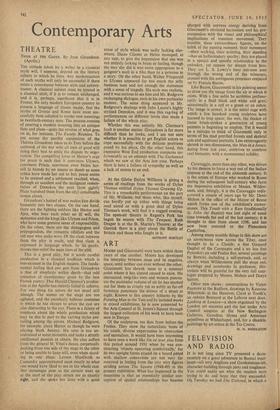MOORE and Giacometti were born within three years of one
another. Moore has developed the interplay between mass and its negative, space, until neither can exist without the other; Giacometti has shrunk mass to a minimal point where it has almost ceased to exist. His attenuated, twig-like men and women punctu- ate the particular volume of air he has marked out for them as crisply yet as softly as far-oft footsteps punctuate the silence of a street at night. Known in this country hitherto by the Pointing Man in the Tate and by isolated works in mixed exhibitions, he is now presented by the Arts Council at St. James's Square through the largest collection of his work to have been seen in Europe.
Of the sculptures, ten date from before the Forties. They show the naturalistic busts of his youth, diverse experiments in abstraction and surrealism. It would have been interesting to have seen a work like On ne tone plus from this period around 1931 when he was con- structing 'objects operating symbolically,' for its two upright forms placed on a board pitted with shallow concavities are not very far removed in feeling from the tiny wiry figures striding across The Square (1948-49) in the present exhibition. What has happened in the meantime is that an essentially similar con- ception of spatial relationships has become charged with nervous energy deriving from Giacometti's etiolated humanism and his pre- occupation with the visual and philosophical imp.fications of transient movement. They tremble, these extraordinary figures, on the brink of the passing moment; their movement —their walking, their pointing, their standing —has an hallucinatory quality; they are placed in a special and specific relationship to the onlooker, yet remain far distant from him. They arc L. S. Lowry's busy ant-men seen through the wrong end of the telescope, crossed with the ambiguous presences conjured up by Francis Bacon.
Like Bacon, Giacometti in his painting seems to draw out the image from the air in which it exists. With a fine sable he scribbles perfunc- torily in a fluid black and white and grey; occasionally in a red or a green or an ochre. The image is atonal; it is the metal cage with which a few hundred young sculptors have learned to trap space; the web, the thicket of linear brush-strokes a generation of young painters is beginning to employ. Yet it would be a mistake to think of Giacometti only in terms of his mad petrified forests and skeletal cats and equivocal portraits. Less extravagantly shrunk in two dimensions, the Man in a Jersey. dating from last year, contrives to combine real humanity with a monumental solidity.
.Caravaggio, more than any other, was driven by his dremon to force a way out of the Italian impasse at the end of the sixteenth century. It is the artists of Europe who worked in Rome during the subsequent half-century who form the impressive exhibition at Messrs. Wilden- stein, and, fittingly, it is the Caravaggio redis- covered a couple of years ago by Mr. Denis Mahon in the office of the Mayor of Rome which forMs one of the exhibition's corner- stones. This Youth with a Ram (traditionally St. John the Baptist) was lost sight of some time towards the end of the last century; it is thought to date from about 1598, and has now been restored to the Pinacoteca Capitolina.
Among many notable things in this show are an anonymous view across the Tiber, once thought to be a Claude; a fine Gaspard Dughct of the Campagna and a no less tine Pynacker; an odd Paulus Bor, several paintings by Bernini. including, a self-portrait, and, as always when Wildenstcins pull the stops out, drawings and notebooks in profusion. His- torians will be grateful for the very full cata- logue prepared by Messrs. Mahon and Denys Sutton.
Other new shows: constructions by Victor Pasmorc at the Redfern, drawings by Katerina Wilczynski at the Hanover, Clavd at Tooth's, an outsize Bonnard at the Lefevre next door, Looking at London—a show organised by the London art societies and the last under Arts Council auspices at the New Burlington Galleries, Grandma Moses and American primitives at Whitechapel, and, for a chuckle, paintings by art critics at the Tea Centre.










































 Previous page
Previous page